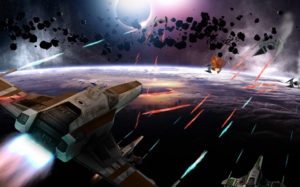Every pilot who expects to fly in combat should become familiar with flying with a wingman. Flying with a wingman has two true purposes, increase offensive capabilities, increase defensive capabilities.
The wingman’s goal is to remain close to leader and warn of any immediate threats. The wingman needs to focus on both the leader and the rear. Two pilots together can warn each and watch each other’s blind spots.
Three standard Formations
Echelon – Offset diagonal. The wingman is typically positioned off the starboard side of the leader, with a varying amount of distance between. Typically, 3-4 ship lengths are common between the leader and the wingman.
Line abreast – Wing to wing, 90 degrees to each other. Again, the distance between can vary on the situation, but one never wants to be too far away or two close.
Stack – Wingman sits high vertically behind leader. As with the other two formations, the distance can vary, but with a high stack, a good distance is usually wanted, but not far enough away that you will be unable to assist each other if need be.
It’s important for pilots to get used to flying both positions, as during combat the roles may reverse at any moment.
Offensive Tactics-
Flying Wing – The leader essentially flies one on one against opponent, while the wingman keeps pace with the leader, keeping an eye out on the leader’s rear. This is best achieved from the echelon formation or a very low stack.
This tactic allows the wingman to be able to fire and assist whenever he has an open shot.
The wingman is exposed to any other ships typically, and only one set of guns is typically pressuring the attack. The wingman has to maintain focus on both following close behind the leader, the leader’s target, and their rear.
Best for pilots to be in the same type of craft so they can keep up with each other. If one vessel constantly has to push their engine to the max or constantly reign in the speed, then that’s another problem to have to deal with at the same time.
Loose Deuce – Same concept of the flying wing, but with much more spacing between the leader and wingman. This allows the wingman to exchange fire more easily towards opponents and can allow a fluid change of position from wingman to leader and vice versa if one pilot loses advantage attacking and another one gains the advantage.
This tactic means the enemy can be constantly kept under pressure. Less communication and discipline is required due to the spacing, the pilots are operating more independently and only need to communicate with change in positioning and other status updates.
This tactic can lead to vulnerabilities from the rear since the wingman is often kept at a greater distance, which requires more time for each other to cover each other. A high attacking opponent can get the jump on both pilots this way.
The Bracket – Pilots fly in the line abreast formation; one pilot draws away the opponent. When the opponent gives chase to the pilot, the pilot than draws the opponent back towards his wingman, the wingman lines up his attack on the opponent as the pilot loses the opponent with a maneuver. This tactic is highly effective when performed successfully but it’s extremely difficult to execute due to the coordination required. If the opponent is lured back too quickly, with the wingman unable to line up his shot, the opponent may have an attempt to take out the pilot he is following.
Defensive Tactics –
Defensive split – The two pilots split, causing the opponent to choose one target to attack. The pilot not be attacked and chased should work his way up and around for an attack on the opponent. This quickly turns the defensive maneuver into an offensive tactic, causing the attacker to get put on the defensive.
While generally very effective, this maneuver doesn’t work when the odds are even or unfavorable. If the two pilots split into opposite directions, if there are two attackers, depending on how they react can lead to this move being successful or not. If both attackers stay on one pilot, then the split can still be turned around and the pilot who is not being chased can attempt to swing their craft around and attack. If the attackers split and each pursue one pilot, then each pilot must engage in maneuvers to attempt to lose their respective attackers.
The Sandwich – The attacker makes a move on one of the two pilots, lead or wing. Whichever pilot is chosen by the attacker, turns away from their wingman. The other pilot, then follows their turn, hopefully causing the attacker to be pulled in between the two pilots. If successful, the attacking ship should end up between the two pilots, allowing the rear pilot an attacking advantage while the lead pilot attempts to avoid fire.
There are hundreds of different maneuvers a pair of pilots can employ together, and it’s impossible for pilots to truly prepare for every situation that might present itself to them, especially in combat. Knowing your ships capabilities, and your wingman’s capabilities gives you the highest chance of success in these situations. As always, a pilot should seek to avoid all actual combat whenever possible, but must be ready to strike hard and fast when necessary.
Zechs Demming
Ace Commander

